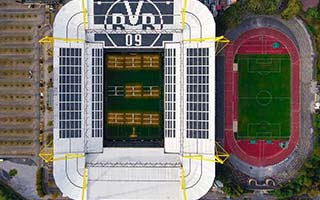WWK Arena (Augsburg Arena)
| Capacity | 30 660 |
|---|---|
| 26 600 (International games capacity) | |
| 20 356 (Seats) | |
| 10 200 (Terraces) | |
| 520 (Business seats) | |
| 51 (Disabled seats) | |
| Country | Germany |
| City | Augsburg |
| Clubs | FC Augsburg |
| Other names | impuls arena (2009–2011), SGL arena (2011–2015) |
| Inauguration | 26.07.2009 |
| Opening game | FC Augsburg – Schwaben-Auswahl, 2–0 |
| Construction | 11.2007 – 07.2009 |
| Renovations | 2017 |
| Cost | 45 mln € |
| Design | Bernhard & Kögl |
| Design time | 2007 |
| Contractor | HBM Stadien- und Sportstättenbau GmbH |
| Address | Bürgermeister-Ulrich-Straße 90, 86199 Augsburg |
Advertisement
WWK Arena – stadium description
How did the new stadium for FC Augsburg come about?
The first plans for a new stadium for FC Augsburg date back to the beginning of the 21st century, shortly after Walther Seinsch became the club's president (he was the main instigator of the new stadium construction). Initially, there were plans to demolish the existing Rosenaustadion and build a new arena in its place, but eventually the decision was made to build a stadium at a completely new location in the southern part of the city on Bundesstraße 17.
The design for the new arena was drawn up by the Bernhard & Kögl architectural team, and HBM Stadien- und Sportstättenbau GmbH was appointed as the main contractor. The construction cost € 45 million, which is not an unreasonable amount for a stadium of this size. 25 million was provided by a group of investors led by Walther Seinsch, 5 million came from the Bavarian budget and 15 million from a loan taken out by the club. The city, on the other hand, allocated 6 hectares of land and financed the works on the stadium's surroundings and transport infrastructure.
When was the new stadium in Augsburg built?
The first groundworks started on November 5, 2007 and the official ground-breaking ceremony took place a little later on November 16, 2007. For cost-saving reasons, the outer facade of the stadium was omitted. The official opening of the new arena took place on July 26, 2009, and for the inauguration the hosts won in a friendly match against the Swabian team 2:0.
How the FC Augsburg's stadium compares to other Bundesliga venues?
What is the name of FC Augsburg's new stadium?
In the planning and construction phase, the stadium was known as Augsburg Arena, but since its opening it has been named after its title sponsor, Impulse Arena. In 2011, SGL Carbon took over as sponsor and the facility was renamed SGL arena. In 2015, after another change of sponsor, the stadium was renamed WWK Arena. In 2017, thanks to funding from the sponsorship company WWK Insurance, the exterior of the stadium was completed.
What events does the WWK Arena host?
On August 7, 2010, the new venue had the opportunity to host the German Super Cup match between Bayern Munich and Schalke 04 (2:0). In 2011, FC Augsburg earned their first promotion to the Bundesliga in the history of the club. In 2011, the stadium was the venue for part of the Women's World Cup (three group stage matches and one quarter-final). The year before, the venue was one of the arenas of the Under-20 Women's World Cup, also held in Germany.
On May 29, 2016, the German national football team played for the first time in this stadium, losing in a friendly match against Slovakia 1:3. Due to heavy rainfall, the break between the first and second halves was significantly extended during this match.
What are the characteristics of the WWK Arena?
The stadium has a football-specific, rectangular layout and is situated on a north-south axis. Single-tier stands surround the pitch on all sides. The auditorium is fully roofed. A certain compromise solution is the placement of canopy pillars in the upper part of the stands. The main stand with VIP boxes and extended supporting facilities is located on the west side. The sections for Augsburg's die-hard supporters, with standing places, are located in the north stand.
As of September 1, 2018, the north stand is named after Ulrich Biesinger, a FC Augsburg alumnus who represented Germany and was part of the national team at the 1954 World Cup, in which the West Germany team won the trophy (Biesinger, however, did not appear in any of the matches of that tournament).
The visitors' section, also with standing places, is located in the south-east corner, while the family zone is situated in the north-west corner. The seating in the stands are red. The stadium has a total capacity of 30,660 spectators, of which 20,856 can be seated (including 800 in the visitors' area). Standing room is approx. 10,200, of which around 2,200 are in the away section. For international matches the standing places are converted into seats and the capacity drops to 26,600 spectators.
The pitch is 8 m below ground level and the first rows of stands are slightly above the field. There are two LED screens in the corners. The facility uses geothermal energy resources by means of deep underground heat pumps. A concept for the possible expansion of the stadium to a capacity of 49,000 spectators (39,880 in the seating-only configuration) was already prepared during the planning phase. According to estimates at the time, the expansion would cost around € 20 million.
The main facade of the stadium, behind which the extensive facilities of the main stand are hidden, is located on the west side. On the other sides, the stands are surrounded by a facade formed from tubes with a diameter of 20 cm, mostly made of aluminium. Some of the tubes are LED lights, which when lit up at night create an impressive illumination. The layout of the tubes is slightly disrupted, many of them are placed at an angle, creating an interesting, seemingly chaotic pattern, and some enter under the stands, giving the installation a three-dimensional design.
In the surroundings of the stadium there are 3500 parking spaces, as well as three full-size training pitches. When the arena was built, an additional section of tram track was also completed, along with a new stop where trams run to when events are held at the venue. On August 1, 2015, a statue of Helmut Haller, FC Augsburg alumnus and 1966 World Cup runner-up, was unveiled near the north-west corner of the stadium. In January 2018, also near the north-west corner, a so-called function building, including a pub and a fan shop, was commissioned.
Advertisement
Pictures
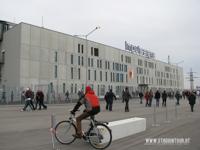
22.10.2010 © Stadiontour.at 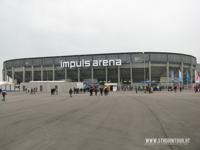
22.10.2010 © Stadiontour.at 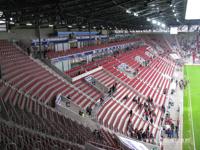
22.10.2010 © Stadiontour.at 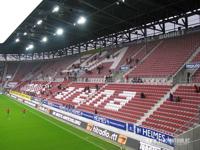
22.10.2010 © Stadiontour.at 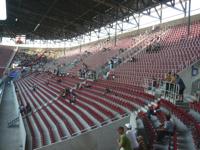
30.08.2009 © Frank Jasperneite 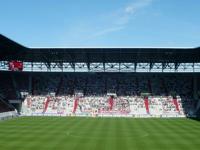
30.08.2009 © Frank Jasperneite 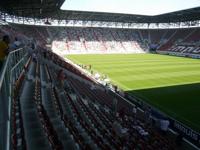
30.08.2009 © Frank Jasperneite 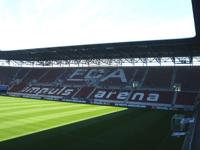
30.08.2009 © Frank Jasperneite
Related news
2022
2021
-
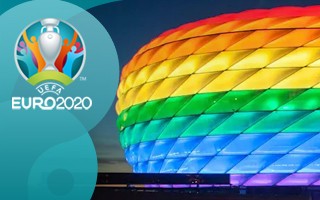
Euro 2020: As UEFA bans rainbow illumination, other stadiums do it
From a simple appeal to an international diplomatic issue, this has really escalated quickly. As UEFA denied the rainbow illumination of Allianz Arena, other stadiums across Germany announce they will be lit in such way.
-

Germany: Rainbow stadiums to commemorate Holocaust
This weekend German stadiums might be more colourful than usually. Illuminations, corner flag, captains’ armbands – these are some of the means to commemorate LGBT people as part of this year’s Remembrance Day in German Football.
2017
-
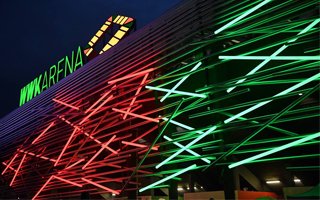
Augsburg: WWK Arena lit up for the first time
Just as promised, they made it before the end of summer. This week WWK Arena in Augsburg saw its brand new illumination light up, celebrating victory against RB Leipzig.
-
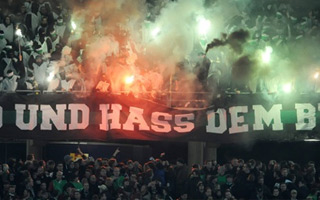
Hannover: Surprise declaration in favour of legal pyrotechnics
If there's one person you would expect to be sceptical of pyro, it's a minister of interior. But it's exactly his announcement in favour of legal flares that sparked new heated discussion in Germany.
-
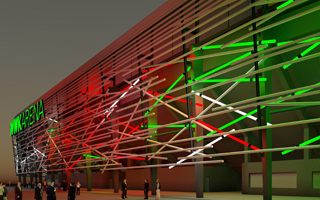
Germany: WWK Arena finally getting its facades
From the 2017/18 season onwards the home ground of FC Augsburg will finally stop being just bare concrete. 20 kilometers of tubes will cover WWK Arena, forming an interesting pattern.
2015
-
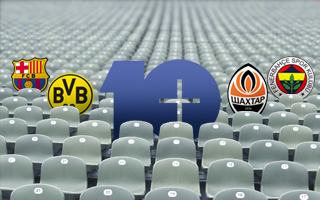
10+ Ranking 2015: Attendances in Europe (Part 2. The Clubs)
Borussia, Barca and Man United – lovely dominant trio. But it wasn’t them who gained most fans last season. Check all 217 clubs that draw an average crowd of 10,000+!
-
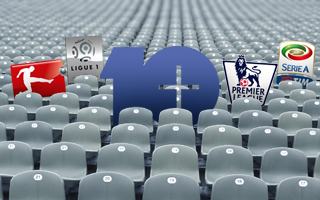
10+ Ranking 2015: Attendances in Europe (Part 1. The Leagues)
Numbers don’t lie: French Ligue 1 outgrew Italian Serie A as Europe’s fourth largest league. Premier League seems unlikely to catch up to Bundesliga, while Turkey, Ukraine and Scotland are down.
2012
-
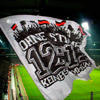
Germany: Controversial safety regulations approved, what now?
Yesterday 36 top clubs voted on proposed safety regulation changes with vast majority in favour. Many fans see this as clamp-down on fan culture, but others are encouraged by events of past few weeks. What's changing inside German stadia?
-
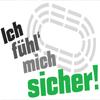
Germany: Fans don’t feel safe?
Temperature around German football safety has been growing for months and is almost as hot as the flares set off by fans inside stadiums. Flares much hated by football governing bodies who suggested a new safety system, claiming people don’t feel safe at football games. They only forgot to ask the people, whether this is the case…
 StadiumDB
StadiumDB